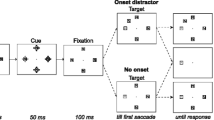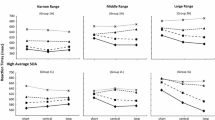Abstract
In a spatial cueing paradigm it was investigated whether endogenous orienting is sensitive to orienting processes in the previous trial. Specifically, the effect of the previous cue direction, the previous trial type (valid, invalid, neutral, catch) and target alternation effects were studied. Strategic effects were shown as attentional costs and benefits were larger after a valid than after an invalid trial. Following catch trials, an overall response slowing was observed, but costs and benefits were unaffected. This was interpreted as a reduction in alertness and as support for the dissociation between spatial and temporal attentional mechanisms. Repetition of target position per se had no effect, but in neutral trials responses were slower to targets appearing at the location that was cued in the previous trial, independent of validity of the preceding trial. This suggests that long-term inhibition-of-return can occur between trials when attention is controlled endogenously.





Similar content being viewed by others
Notes
The pattern of results was the same when these subjects were included, but effects were stronger without them.
References
Alegria, J. (1978). Sequential effects of catch-trials on choice reaction time. Acta Psychologica, 42, 1–6.
Beringer, J. (1987). Experimental Run Time System (Version 3.32c). Frankfurt, Germany: Berisoft Cooperation.
Bertelson, P. (1961). Sequential redundancy and speed in a serial two-choice responding task. Quarterly Journal of Experimental Psychology, 13, 90–102.
Bertelson, P. (1963). S–R relationships and reaction times to new versus repeated signals in a serial task. Journal of Experimental Psychology, 65, 478–484.
Bertelson, P., & Renkin, A. (1966). Reaction times to new versus repeated signals in a serial task as a function of response-signal time interval. Acta Psychologica, 25, 132–136.
Correa, A., Lupiáñez, J., Milliken, B., & Tudela, P. (2004). Endogenous temporal orienting of attention in detection and discrimination tasks. Perception and Psychophysics, 66, 264–278.
Coull, J. T., & Nobre, A. C. (1998). Where and when to pay attention: The neural systems for directing attention to spatial locations and to time intervals as revealed by both PET and fMRI. Journal of Neuroscience, 18, 7426–7435.
Eriksen, B. A., & Eriksen, C. W. (1974). Effects of noise letters upon the identification of a target letter in a nonsearch task. Perception and Psychophysics, 16, 143–149.
Fernandez-Duque, D., & Posner, M.I. (1997). Relating the mechanisms of orienting and alerting. Neuropsychologia, 35, 477–486.
Gordon, I. E. (1967). Stimulus probability and simple reaction time. Nature, 215, 895–896.
Gratton, G., Coles, M. G., & Donchin, E. (1992). Optimizing the use of information: Strategic control of activation of responses. Journal of Experimental Psychology: General, 121, 480–506.
Griffin, I. C., Miniussi, C., & Nobre, A. C. (2002). Multiple mechanisms of selective attention: Differential modulation of stimulus processing by attention to space or time. Neuropsychologia, 40, 2325–2340.
Hommel, B. (2004). Event files: feature binding in and across perception and action. Trends in Cognitive Sciences, 8, 494–500.
Hommel, B., Proctor, R.W., & Vu, K.L. (2004). A feature-integration account of sequential effects in the Simon task. Psychological Research, 68, 1–17.
Hyman, R. (1953). Stimulus information as a determinant of reaction time. Journal of Experimental Psychology, 45, 188–196.
Jonides, J. (1981). Voluntary versus automatic control over the mind’s eye’s movement. In J. Long (Ed.), Attention and performance IX: 9th international symposium, Cambridge, July (Vol. IX, pp. 187–203). Hillsdale: Erlbaum.
Kirby, N. H. (1976). Sequential effects in two-choice reaction time: Automatic facilitation or subjective expectancy? Journal of Experimental Psychology: Human Perception and Performance, 2, 567–577.
Kirby, N. H. (1980). Sequential effects in choice reaction time. In A. T. Welford (Ed.), Reaction times (pp. 129–172). London: Academic Press.
Kwak, H., & Egeth, H. (1992). Consequences of allocating attention to locations and to other attributes. Perception and Psychophysics, 51, 455–464.
Los, S. (2004). Inhibition of return and non-specific preparation: separable inhibitory control mechanisms in space and time. Perception and Psychophysics, 66, 119–130.
Maylor, E. A., & Hockey, R. (1987). Effects of repetition on the facilitatory and inhibitory components of orienting in visual space. Neuropsychologia, 25, 41–54.
McKenna, F.P., & Sharma, D. (2004). Reversing the emotional Stroop effect reveals that it is not what it seems: the role of fast and slow components. Journal of Experimental Psychology, Learning, Memory, and Cognition, 30, 382–392.
Milliken, B., Lupiáñez, J., Roberts, M., & Stevanovski, B. (2003). Orienting in space and time: Joint contributions to exogenous spatial cuing effects. Psychonomic Bulletin and Review, 10, 877–883.
Näätänen, R. (1972). Time uncertainty and occurrence uncertainty of the stimulus in a simple reaction time task. Acta Psychologica, 36, 492–503.
Posner, M. I. (1980). Orienting of attention. Quarterly Journal of Experimental Psychology, 32, 3–25.
Posner, M. I., & Cohen, Y. (1984). Components of visual orienting. In H. Bouma (Ed.), Attention and Performance X: control of language processes (pp. 531–556). London: Erlbaum.
Posner, M. I., & Petersen, S. E. (1990). The attention system of the human brain. Annual Review of Neuroscience, 13, 25–42.
Posner, M. I., Nissen, M. J., & Ogden, W. C. (1978). Attended and unattended processing modes: the role of set for spatial location. In H. L. Pick & E. Saltzman (Eds.), Modes of perceiving and processing information (pp. 137–157). Hillsdale: Lawrence Erlbaum Associates.
Posner, M. I., Snyder, C.R.R., Davidson, B.J. (1980). Attention and the detection of signals. Journal of Experimental Psychology, 109, 160–174.
Posner, M.I., Rafal, R.D., Chaote, L.S., Vaughan, J. (1985). Inhibition of return: Neural basis and function. Cognitive Neuropsychology, 2, 211–228.
Pratt, J., & Abrams, R.A. (1999). Inhibition of return in discrimination tasks. Journal of Experimental Psychology: Human Perception and Performance, 25, 229–242.
Rafal, R. D., Calabresi, P. A., Brennan, C. W., & Sciolto, T. K. (1989). Saccade preparation inhibits reorienting to recently attended locations. Journal of Experimental Psychology: Human Perception and Performance, 15, 673–685.
Ridderinkhof, K. R. (2002). Micro- and macro-adjustments of task set: activation and suppression in conflict tasks. Psychological Research, 66, 312–323.
Snodgrass, J. G. (1969). Foreperiod effects in simple reaction time: Anticipation or expectancy? Journal of Experimental Psychology, 79, 1–19.
Soetens, E. (1990). Sequential effects in two-choice reaction time. Unpublished doctoral dissertation, University of Leiden, Leiden, The Netherlands.
Soetens, E. (1998). Localizing sequential effects in serial choice reaction time with the information reduction procedure. Journal of Experimental Psychology: Human Perception and Performance, 24, 547–568.
Stürmer, B., Leuthold, H., Soetens, E., Schröter, H., & Sommer, W. (2002). Control over location-based response activation in the Simon task: behavioral and electrophysiological evidence. Journal of Experimental Psychology: Human Perception and Performance, 28, 1345–1363.
Taylor, T.L., & Klein, R.M. (2000). Visual and motor effects in inhibition of return. Journal of Experimental Psychology, 26, 1639–1656.
Tipper, S.P., Grison, S., & Kessler, K. (2003). Long-term inhibition of return of attention. Psychological Science, 14, 19–25.
Acknowledgements
We thank Sander Los, Juan Lupiáñez, Jay Pratt, and two anonymous reviewers for their comments on earlier versions of the manuscript.
Author information
Authors and Affiliations
Corresponding author
Rights and permissions
About this article
Cite this article
Jongen, E.M.M., Smulders, F.T.Y. Sequence effects in a spatial cueing task: Endogenous orienting is sensitive to orienting in the preceding trial. Psychological Research 71, 516–523 (2007). https://doi.org/10.1007/s00426-006-0065-3
Received:
Accepted:
Published:
Issue Date:
DOI: https://doi.org/10.1007/s00426-006-0065-3




